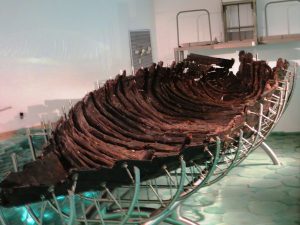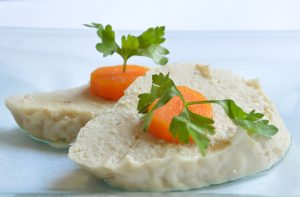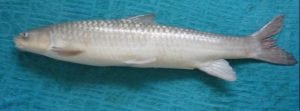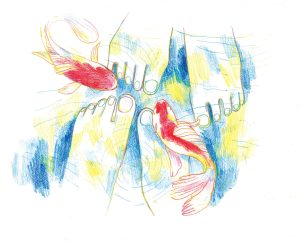Too many fish in the sea? On Bava Kamma 41b-42a, the Gemara brings an analogy to a fisherman who throws back some fish and keeps others. Was fishing and eating fish a common pursuit in Talmudic times?
Israel, and Babylonia are countries that have bodies of water, and therefore fish. In Israel there are both marine fish from the Mediterranean, and freshwater fish from the Kinneret and the Jordan (no fish from the Dead Sea, sorry). In Babylonia, the two powerful rivers, Euphrates and Tigris, and their tributaries, provide many fish for local consumption. The Torah instructs us as to the signs of kosher fish but does not list any particular permitted or forbidden species:
“These you may eat of all that live in water: anything in water, whether in the seas or in the streams, that has fins and scales—these you may eat. (Vayikra 11:9)
Fish was a staple food for the Israelite slaves in Egypt, and they complained when they were deprived of it in the desert:
“We remember the fish that we used to eat free in Egypt, the cucumbers, the melons, the leeks, the onions, and the garlic.” (Bamidbar 11:5)
After settling in the Land of Israel, fish remained a common food, despite many Israelites not living near a body of water. One of the fascinating discoveries in Jerusalem archaeology is the presence of fish bones in garbage dumps in the City of David through the ages, from First Temple times through to the early Islamic period. We even find references to the fish trade in Tanakh: a few places mention a “fish gate” in Jerusalem and Nehemiah admonishes the fish sellers who hawk their wares on Shabbat:
“Tyrians who lived there brought fish and all sorts of wares and sold them on the Sabbath to the Judahites in Jerusalem.” (Nehemiah 13:16)
These fish were not sold fresh; that would have been very difficult considering the distance from the coast to Jerusalem. Rather, they were probably dried, salted or smoked. The presence of so many bones indicates to us that Jerusalem was a wealthy city that could afford “imported” delicacies. Fish was so prevalent that the original symbol in ancient Hebrew writing for the letter dalet was a sign that looked like a fish, a dag:

Modern (right) and ancient (middle and left) dalets
In other parts of the country, fish could be caught and eaten fresh. The Mishnah and Gemara mention various kinds of nets and traps for catching fish and discuss whether such traps can be used on Yom Tov:
“One may not trap fish from their ponds on a festival. . .” (Betzah 3:1)
One of the rules that Joshua ben Nun instituted, according to the Talmudic statement in Bava Kamma (81a) is that fish in the Kinneret can be caught by anyone, even though technically the actual body of water belongs to the tribe of Naftali.
Fishing on the Kinneret certainly was a common occupation. In the excavation of the town of Migdal, just north of Tiberias, archaeologists found basins that were used to salt and preserve fish, the fish that was caught meters away in the Kinneret. In fact, Josephus tells us that Migdal’s name in Greek was Tarichaea, which means salted fish, and it is called in our sources Migdal Nunia, nun being the Aramaic word for fish. In the New Testament, when Jesus goes in search of disciples, he finds two men, Simon and Andrew, fishing on the Kinneret. He tells them to join him and instead to become “fishers of men,” i.e., teachers of his new ideas to the masses (Matthew 4:19). In 1986, in a drought year, the remains of a two thousand-year old wooden fishing boat were discovered in the Kinneret. It was dubbed the Jesus boat, and was preserved and displayed in a museum in Ginossar:

Yehudit Garinkol Pikiwiki Israel, CC BY 2.5 <https://creativecommons.org/licenses/by/2.5>, via Wikimedia Commons
Fish are not only good to eat, they are full of symbolism as well. They are considered to be signs of both fertility and good luck and as such appeared on marriage contracts and on mohels’ implements. As the only creatures not killed in the flood in Noah’s time, they were also thought to be free from sin. Fish (Pisces) are the zodiac sign for the Hebrew month of Adar, the month of the holiday of Purim, and so they also became a popular Purim symbol. And fish for the Shabbat meal has been a tradition for centuries. When the Gemara in Shabbat (119a) wishes to describe how the rabbis helped prepare for Shabbat, one example is of Rava salting a fish. Even today, fish is an integral part of many Shabbat meals.

Gefilte – a fish unknown to the Talmud
Mushki Brichta, CC BY-SA 4.0 <https://creativecommons.org/licenses/by-sa/4.0>, via Wikimedia Commons
What kind of fish were our ancestors eating? The bones found in the City of David show a prevalence of kosher fish like sea bream and Nile perch, along with a few non-kosher species like catfish and shark. The Kinneret fish were most likely tilapia and carp. In a few places in Rabbinic literature we have a reference to a fish called the shibuta. It seems to have been common in Babylonia and in fact Yalta, Rabbi Nahman’s wife, claimed that it tasted like pork and was created by God to allow Jews to taste a forbidden food (Hullin 109b)! Commentators through the ages have tried to identify this fish but it took halakhic adventurers Dr. Ari Zivotofsky and Dr, Ari Greenspan to find it. They learned of a fish that is common in the Euphrates called the shabut and realized that this must be the shibuta. Undaunted by the fact that much of the Euphrates runs in countries hostile to Israel and Jews, they managed to travel to the river, eat the fish and even transport some to Los Angeles for a banquet. Read the full story here: https://www.jpost.com/jewish-world/jewish-features/holy-shibuta

A shabut fish (Barbus grypus)
seyedahmadreza Hashemi, CC BY 3.0 <https://creativecommons.org/licenses/by/3.0>, via Wikimedia Commons
Today we have artificial fish ponds to raise fish for food but there are still plenty of fish naturally filling our lake and our streams. Sometimes people even like fish nibbling at their skin to give them a natural pedicure.

Original artwork by Noa Mishkin










